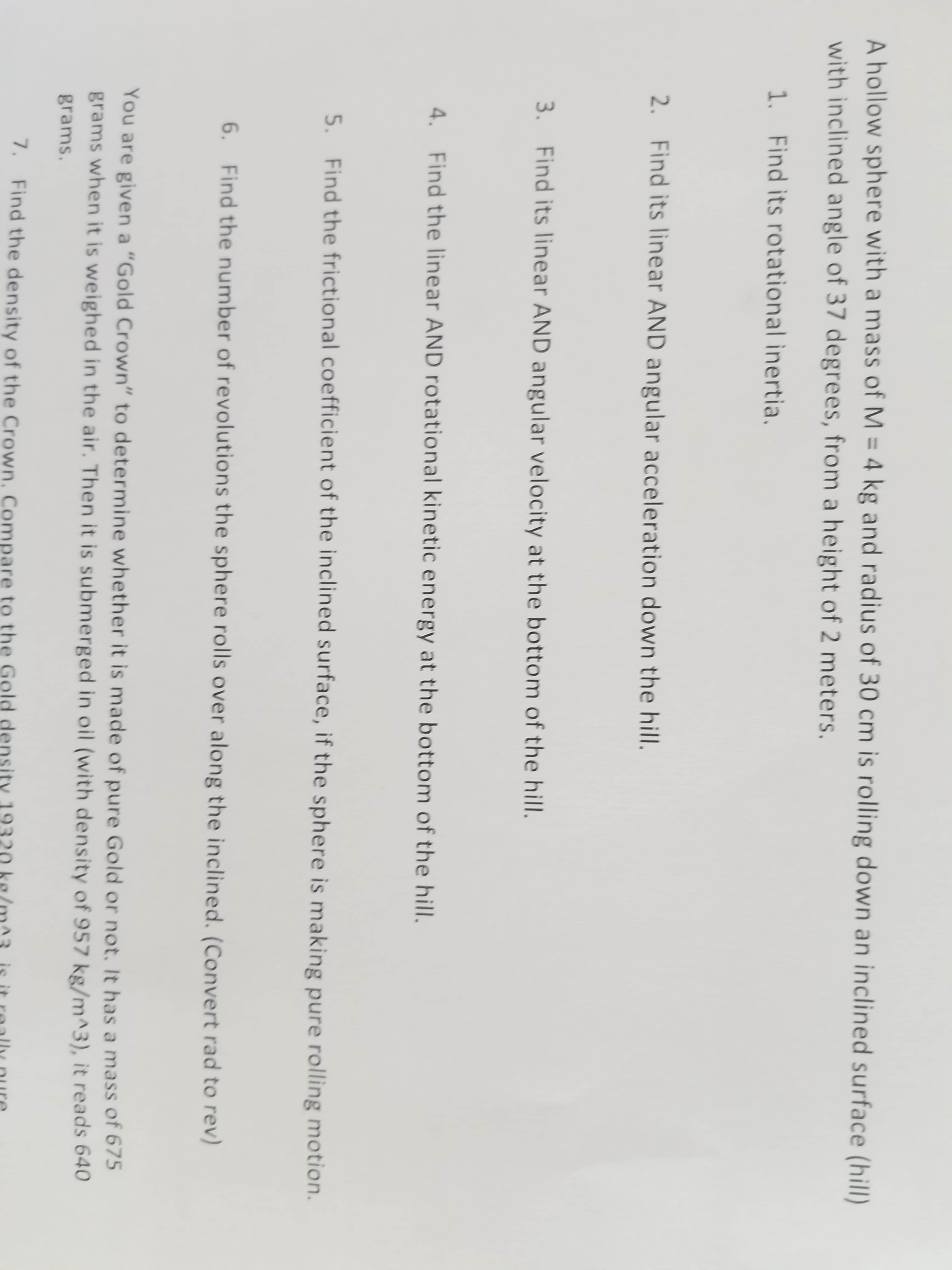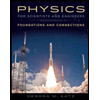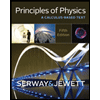A hollow sphere with a mass of M 4 kg and radius of 30 cm is rolling down an inclined surface (hill) with inclined angle of 37 degrees, from a height of 2 meters. 1. Find its rotational inertia. 2. Find its linear AND angular acceleration down the hill. 3. Find its linear AND angular velocity at the bottom of the hill. 4. Find the linear AND rotational kinetic energy at the bottom of the hill. 5. Find the frictional coefficient of the inclined surface, if the sphere is making pure rolling motion. 6. Find the number of revolutions the sphere rolls over along the inclined. (Convert rad to rev) You are given a "Gold Crown" to determine whether it is made of pure Gold or not. It has a mass of 675 grams when it is weighed in the air. Then it is submerged in oil (with density of 957 kg/m^3), it reads 640 grams. 7. Find the density of the Crown. Compare to the Gold
A hollow sphere with a mass of M 4 kg and radius of 30 cm is rolling down an inclined surface (hill) with inclined angle of 37 degrees, from a height of 2 meters. 1. Find its rotational inertia. 2. Find its linear AND angular acceleration down the hill. 3. Find its linear AND angular velocity at the bottom of the hill. 4. Find the linear AND rotational kinetic energy at the bottom of the hill. 5. Find the frictional coefficient of the inclined surface, if the sphere is making pure rolling motion. 6. Find the number of revolutions the sphere rolls over along the inclined. (Convert rad to rev) You are given a "Gold Crown" to determine whether it is made of pure Gold or not. It has a mass of 675 grams when it is weighed in the air. Then it is submerged in oil (with density of 957 kg/m^3), it reads 640 grams. 7. Find the density of the Crown. Compare to the Gold
Physics for Scientists and Engineers: Foundations and Connections
1st Edition
ISBN:9781133939146
Author:Katz, Debora M.
Publisher:Katz, Debora M.
Chapter13: Rotation Ii: A Conservation Approach
Section: Chapter Questions
Problem 32PQ
Related questions
Question
Question 1 2 and 3

Transcribed Image Text:A hollow sphere with a mass of M 4 kg and radius of 30 cm is rolling down an inclined surface (hill)
with inclined angle of 37 degrees, from a height of 2 meters.
1. Find its rotational inertia.
2.
Find its linear AND angular acceleration down the hill.
3.
Find its linear AND angular velocity at the bottom of the hill.
4.
Find the linear AND rotational kinetic energy at the bottom of the hill.
5.
Find the frictional coefficient of the inclined surface, if the sphere is making pure rolling motion.
6.
Find the number of revolutions the sphere rolls over along the inclined. (Convert rad to rev)
You are given a "Gold Crown" to determine whether it is made of pure Gold or not. It has a mass of 675
grams when it is weighed in the air. Then it is submerged in oil (with density of 957 kg/m^3), it reads 640
grams.
7. Find the density of the Crown. Compare to the Gold
Expert Solution
Trending now
This is a popular solution!
Step by step
Solved in 9 steps with 8 images

Knowledge Booster
Learn more about
Need a deep-dive on the concept behind this application? Look no further. Learn more about this topic, physics and related others by exploring similar questions and additional content below.Recommended textbooks for you

Physics for Scientists and Engineers: Foundations…
Physics
ISBN:
9781133939146
Author:
Katz, Debora M.
Publisher:
Cengage Learning

University Physics Volume 1
Physics
ISBN:
9781938168277
Author:
William Moebs, Samuel J. Ling, Jeff Sanny
Publisher:
OpenStax - Rice University

College Physics
Physics
ISBN:
9781938168000
Author:
Paul Peter Urone, Roger Hinrichs
Publisher:
OpenStax College

Physics for Scientists and Engineers: Foundations…
Physics
ISBN:
9781133939146
Author:
Katz, Debora M.
Publisher:
Cengage Learning

University Physics Volume 1
Physics
ISBN:
9781938168277
Author:
William Moebs, Samuel J. Ling, Jeff Sanny
Publisher:
OpenStax - Rice University

College Physics
Physics
ISBN:
9781938168000
Author:
Paul Peter Urone, Roger Hinrichs
Publisher:
OpenStax College

Principles of Physics: A Calculus-Based Text
Physics
ISBN:
9781133104261
Author:
Raymond A. Serway, John W. Jewett
Publisher:
Cengage Learning